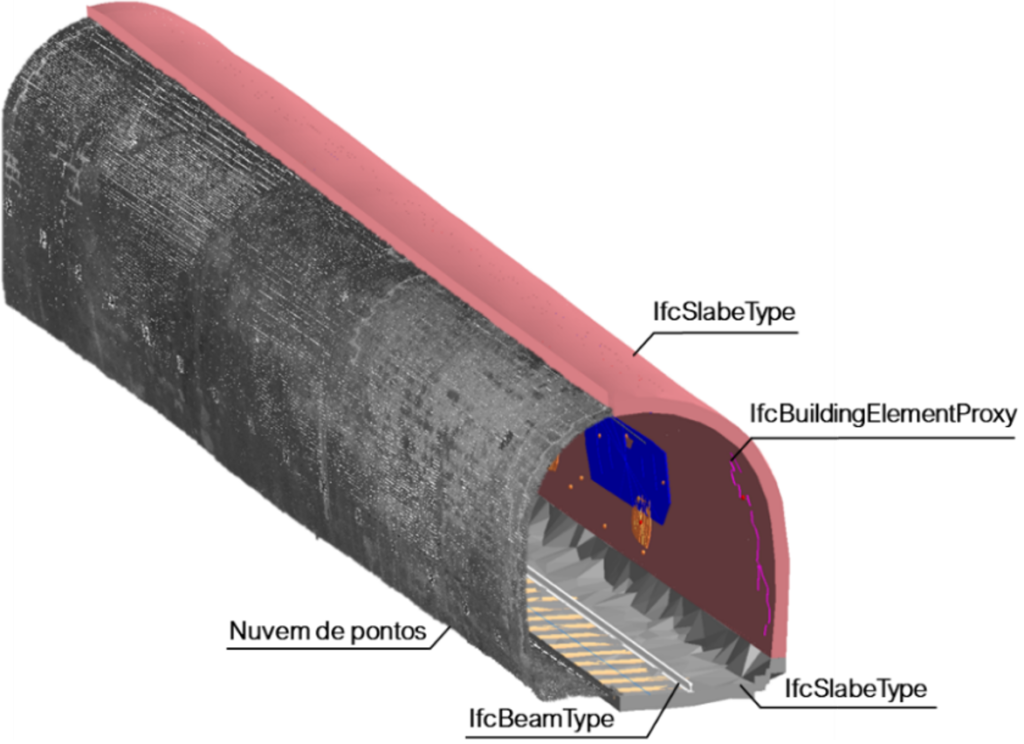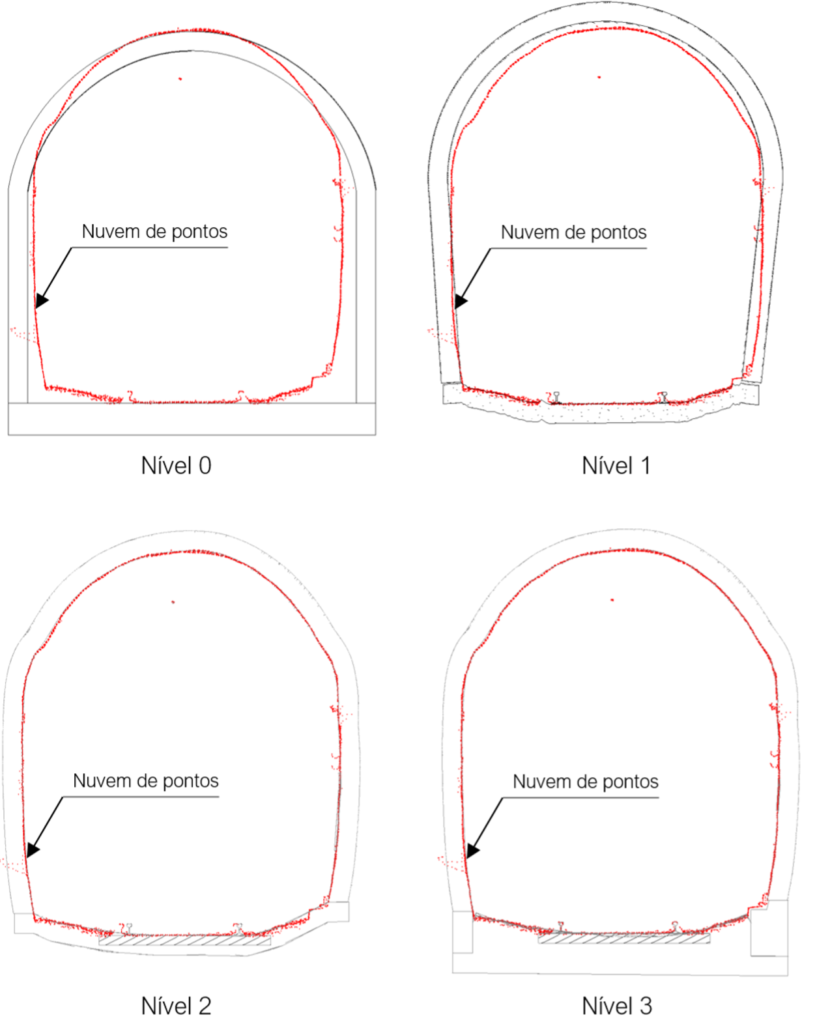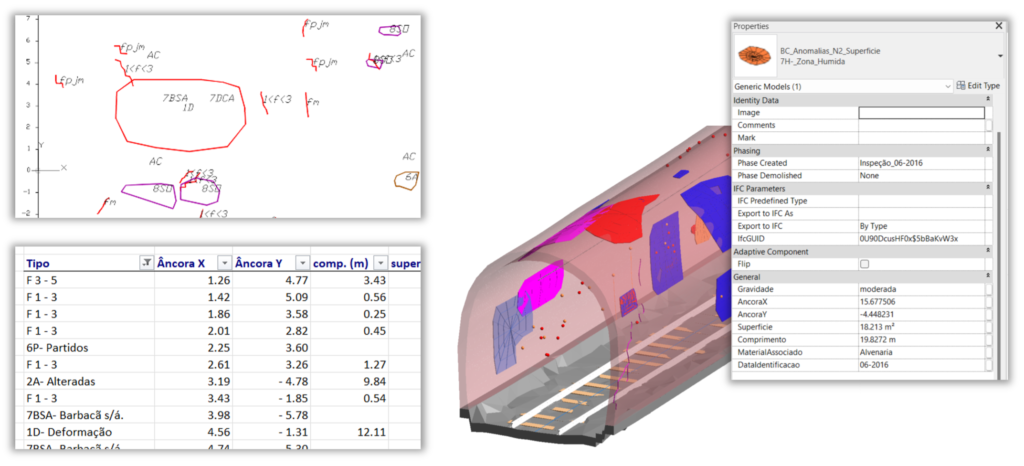Context
BUILT CoLAB has collaborated with Infraestruturas de Portugal (IP) to develop strategies for digitising its railway heritage. This partnership took place within the scope of the innovation and development project RoboShot@FRC – Robotic System for Optimised Projection of Fibre-Reinforced Concrete in Railway Tunnels; and involved the creation of Artificial Intelligence algorithms capable of automating a large part of the Building Information Modelling (BIM) process for IP’s railway tunnels. This automation was made possible through the use of the tunnels’ point clouds in conjunction with the Scan-to-BIM methodology, which also made it possible to incorporate the geometry and information associated with the anomalies identified. The partnership culminated in the creation of a BIM platform capable of supporting the centralised management of all the information associated with IP’s 79 railway tunnels.
Figure 1 shows a view of one of the BIM models resulting from this digitisation, where you can see the original point cloud and the various elements modelled from it.

Solution
The solution developed by BUILT CoLAB integrates a Scan-to-BIM methodology capable of automating part of the modelling tasks involved in creating the digital repository (see “Scan-to-BIM” section) and a graphical interface to link the repository to the Autodesk Revit modelling tool (Figure 2).
Through this interface, the user has access to the list of tunnels in the digital repository and can view the respective information, e.g. location, size, line ID, anomalies identified, etc. (Figure 3), as well as open the respective BIM model in the modelling environment. As well as making it easier to view and manipulate the data contained in the models, this solution simplifies their sharing and constant updating throughout the life cycle of the digitised tunnels.


Scan-to-BIM
The algorithmic strategy implemented to materialise the point clouds of railway tunnels into 3D surfaces is illustrated in Figure 4. This involved cleaning up the original point cloud and creating profiles representative of the geometry of its surroundings, subsequently using the profiles obtained to generate the tunnel’s envelope layer. Depending on the number of profiles selected, the tunnel is automatically modelled with greater or lesser rigour. However, this rigour is balanced by the cloud’s processing time (i.e. more profiles, longer processing time).
Figure 5 shows 3 BIM models of the same tunnel generated using a set of algorithms which, based on topographic surveys, inspection data and tunnel databases, parameterise and model the respective BIM elements with the desired level of detail: for example, while model A only represents the ballast and the structural layer of the tunnel modelled in a generic way, model B already has some geometric rigour and also more elements, e.g. the rails and anomalies. Similarly, model C has even more rigour and more elements, e.g. catenary, sleepers, as well as different categories of anomalies.
This contrast in modelling accuracy is also visible in Figure 6, where we can see a cross-section of the original point cloud superimposed on the automatically generated models. It can be seen that the accuracy of the modelling increases throughout the modelling levels, culminating in level 3, which shows a “digital twin” of the tunnel.



Anomalies and structural calculation model
Figure 7 illustrates the sources of information that serve as the basis for the algorithms to instantiate the BIM elements relating to tunnel anomalies: on receiving the data collected in inspections, the algorithm creates instances of the respective types of anomalies, parameterising and mapping them accordingly.

In addition to BIM modelling, the algorithmic process implemented also makes it possible to extract information for structural calculation tools. This process is illustrated in Figure 8. The result is a polygonal mesh corresponding to the intermediate points of the underpinning layer represented (Figure 9.A), which is then converted into a format compatible with the structural calculation tool (Figure 9.B).


Product Data Templates
Standardisation plays a fundamental role in implementing the BIM methodology and is essential for improving the collaborative process between the various players involved in the life cycle of built assets. Defining and standardising alphanumeric information for construction products is a challenge facing the construction industry, which has been tackled by means of Product Data Templates (PDTs). To this end, and in order to increase the number of PDTs available to the sector, this project developed PDTs for railway tunnel elements, such as the bearing layer, fibre shotcrete layer, rail, sleeper, rail fastening system, ballast and anomalies. These PDTs were developed in accordance with the guidelines set out in the EN ISO 23387 and EN ISO 23386 standards and are available on the national PDT platform at https://pdts.pt.
Conclusion
The work carried out resulted in a set of strategies to support the digitisation of railway tunnels and their integration into a shared access digital platform. Of particular note were the algorithms developed to convert different IP databases into BIM models, which made it possible to reduce the time and effort invested in this task. Also noteworthy is the graphical interface developed for the Autodesk Revit modelling tool to manage the BIM models generated, facilitating access to and coordination of information in a centralised and synchronous way with the evolution of the digitised tunnel.
Team
Several BUILT CoLAB members took part in the project, namely Débora Pinto, Inês Caetano, João Silva, Margarida Amândio, Yessica Barbosa, and Luís Sanhudo, as well as the support of Hugo Patrício from Infraestruturas de Portugal, and José Granja, Miguel Azenha and Mohammed El Sibaii from the University of Minho.
Scientific Publications
“Gestão de Infraestruturas Públicas Através do BIM: Modelação de Túneis Ferroviários das Infraestruturas de Portugal” – Revista de Ativos de Engenharia.
“BIM em Infraestruturas Ferroviárias: Modelação automática de túneis para monitorização e manutenção ao longo do ciclo de vida” – ptBIM – 5º Congresso Português de ‘Building Information Modelling’.

